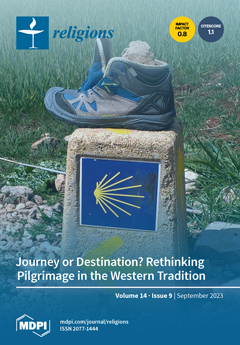According to available biography materials, Fazang had six disciples, namely, Hongguan (宏觀), Wenchao (文超), Zhiguang (智光) of Huayansi in the East Capital (東都華嚴寺), Zongyi (宗一) of He’ensi (荷恩寺), Huiyuan (慧苑) of Jingfasi (靜法寺), and Huiying (慧英) of Jingxingsi (經行寺). Most studies on Fazang’s
[...] Read more.
According to available biography materials, Fazang had six disciples, namely, Hongguan (宏觀), Wenchao (文超), Zhiguang (智光) of Huayansi in the East Capital (東都華嚴寺), Zongyi (宗一) of He’ensi (荷恩寺), Huiyuan (慧苑) of Jingfasi (靜法寺), and Huiying (慧英) of Jingxingsi (經行寺). Most studies on Fazang’s dharma lineage have only focused on Huiyuan because only Huiyuan’s works on Buddhism are still extant. However, Huiyuan has been criticized because “he rebelled against his master’s doctrines, and then was taken placed by Chengguan (澄觀) who was born a hundred years later 弟子慧苑悉叛其說, 滅后百年而得澄觀”. Therefore, research on Huiyuan is not mainstream either. This has led to a lack of studies on the Huayan School during the time between Fazang and Chengguan. In fact, Wenchao, a disciple of Fazang, authored ten volumes of
Zifang Yiwangji (自防遺忘集) and one volume of
Huayanjing Guanmai Yiji (華嚴經関脈義記) (hereinafter referred to as
Guanmai (関脈)), and
Guanjian (関鍵: the number of its volumes is unknown, and its text is most likely to be part of
Zifang Yiwangji); Fashen (法詵), a disciple of Huiyuan, wrote
Huayanjing Shu(華嚴經疏, thirty-one volumes); Kuaiji Shenxiu (會稽神秀), a disciple of Fashen, wrote the
Commentary on the Avataṃsaka Sūtra (
Huayanjing Shu (華嚴經疏), thirty volumes) and
Miaoli Yuanchengguan (
妙理圓成觀, three volumes). However, research on these figures is limited. This paper aims to enrich and supplement the study of the Dharma lineage of Fazang by examining the writings of Wenchao, Fashen, and Kuaiji Shenxiu and the ideas revealed by their manuscripts, which may further contribute to the study of the history of Huayan Buddhism and the history of Buddhist schools.
Full article





